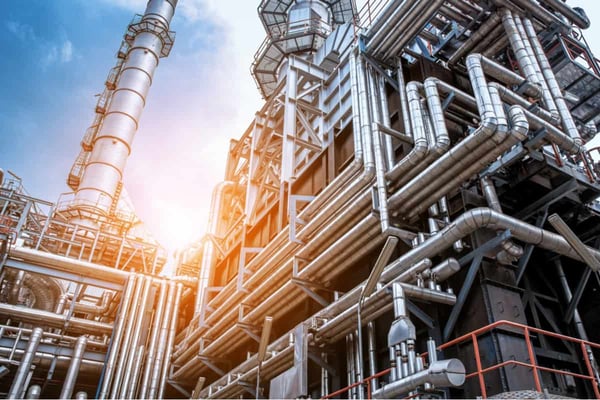Share this
Mitigating Dry Gas Seal Nitrogen Consumption in Northern California Refineries
by Malik Durojaiye on 11/9/21 9:00 AM

Northern California refineries rely on dry gas seals to supply nitrogen at the correct pressure and flow. Failure of the dry gas seal faces may result in damage to the seal, a buildup of pressure from other gasses not being properly released, and eventually damage to components throughout the system. Ultimately, this could result in shutting down refinery operations as well as additional risks of gasses being released into the atmosphere. The continual and optimal flow of nitrogen gas is a concern that operators need to constantly monitor.
There are several reasons that the flow of nitrogen gas may not be optimized. Issues with components throughout the system could be preventing the appropriate flow of nitrogen gas or result in leaks of nitrogen. A decrease in outlet pressure could be caused by an increase in flow rate through a pressure-reducing regulator (an issue known as “droop”). The inverse relationship between inlet and outlet pressure (known as the supply-pressure effect) might be substandard.
To compensate for such issues, operators may set nitrogen flow higher or lower than optimal to prevent the risk of seal damage and operational issues. This too has its own issues; operations have additional waste, costs are higher to replace nitrogen tanks more frequently, and, conversely, the overuse of nitrogen leading to depletion of nitrogen tanks may increase the chances that operations are running without high enough flow of nitrogen (and result in the ensuing damage to seal faces).
In this article, we will examine the importance of nitrogen gas to critical refinery operations and the reasons for suboptimal nitrogen use in operations.
The Importance of Nitrogen Gas in Refinery Processing
The optimal flow of nitrogen is mission-critical for seals to operate effectively and reliably. Seals have two faces—the stationary face and the rotating face—that ideally will operate with limited wear during usage. To achieve this goal, pressurized gas is moved by grooves on seal faces to flow into a small gap between the seal faces. When between the two faces, the gas increases the pressure between the faces and causes the faces to separate. This prevents the seal faces from touching and rubbing and prevents damage to the seal. Though nitrogen is not the only gas used as a separation gas for seals, it is the most widely used and preferred gas option due to its favorable safety profile (other gas options may be more combustible or toxic and thus create other issues).
Nitrogen gas may also be used as a barrier gas. In refinery operations, when there is a labyrinth with the seal, the nitrogen gas prevents other gasses from leaving by a pressure differential within that labyrinth. This prevents the leakage of sometimes toxic or environmentally damaging gasses into the surrounding atmosphere.
Problems can occur when there is poor nitrogen flow. If the seal faces are not properly separated during operations, there will be increased contact between the faces and damage will occur to the seal. Further, the seal may not fully separate and pressure may build up beyond the maximum pressure rating of components throughout the system and result in damage to these components.
With these factors in mind, we will now discuss the potential causes for suboptimal nitrogen usage.
Potential Causes of Suboptimal Nitrogen Usage
Several issues during operation may result in suboptimal nitrogen usage. These include component issues and operator errors.
Impurities and Contaminant Issues in the Nitrogen
Nitrogen must be dry and clean to achieve the correct pressure and flow across the seal. Impurities and contaminants in the nitrogen will damage the seal and may result in an overuse of nitrogen to achieve the necessary force to separate the damaged seal.
Upstream Sources and Piping
The nitrogen delivery system could have problematic issues that are resulting in the overuse of nitrogen. Damaged or accidentally closed valves may cause a loss of nitrogen or overuse of nitrogen to create enough pressure and flow.
Control Valves
Poorly implemented control valves may impact the amount of pressure and flow achieved with nitrogen gas. A control valve that fails to regulate the flow of substances results in inefficient processing and a build-up in pressure or temperature. This may ultimately result in damage to pipes and upstream components necessary to efficiently release nitrogen into the system.
Dry Gas Seal Failure
A damaged dry gas seal may require additional nitrogen to create separation of the seal faces. This, in turn, may result in additional damage to the seal. Causes of damage to seal faces include dirt particles and contaminants in the system and damage to the small grooves. The small grooves are necessary for administering seal gas at the correct flow and pressure to separate the seal.
The Auto Changeover Manifold
An auto changeover manifold delivers gas to a system without interrupting the flow of gas. They often utilize two stages to reduce the pressure that, ideally, results in constant outlet pressure. However, poor integration of an auto changeover manifold may result in gas leakage when changing between cylinders.
Poor Integration of a Dry Gas Seal Support System
Components of a dry gas seal support system need to be fully integrated to limit nitrogen inefficiency in the system. The pressure, flow, volume, and temperature of the gasses used in production need to be properly controlled. Monitoring processes need to alert operators when gas leaks occur. Filtering of seal gas needs to properly prevent contaminants from entering the system. Issues with any components of the dry gas seal support system may result in additional wear and tear on components and waste of nitrogen gas.
Operator Overuse of Nitrogen Gas
A common inefficiency in operation is operator overuse of nitrogen gas. Operators may believe that by increasing the flow of nitrogen gas that they can ensure proper separation of seal faces. However, in a well-maintained and fully integrated system, this is costly, wasteful, and creates additional pollutants. In addition, it more quickly depletes nitrogen tanks and increases risks that operators were initially trying to avoid; that is, issues of lack of nitrogen in the system resulting in damage to seal faces.
The potential causes of suboptimal nitrogen usage are varied. However, when utilizing a fully integrated system at the proper specifications, it can be limited. Consulting with an expert on how to successfully integrate a seal support system can help prevent suboptimal use of nitrogen.
Expert Guide to Mitigate Dry Gas Seal Nitrogen Consumption
The reasons for overusing nitrogen at refineries can be related to a lack of a fully integrated system, leaks and damaged components, and operator use. Luckily, these issues can all be mitigated when working with an expert in dry gas seals and integrating system operations. By working with Swagelok, manifolds, control valves, and dry gas seals can be updated based on your specific operational needs. A Swagelok Field Engineer can work with your team to determine the most efficient release of nitrogen to keep seals running smoothly as well as to limit quick depletion of nitrogen tanks.
To find out more about how Swagelok Northern California can help with mitigating nitrogen gas consumption at your plant, contact our team today by calling 510-933-6200.

About Malik Durojaiye | Field Engineer, Assembly Services
Malik Durojaiye began his Swagelok career in 2019 as a Custom Solutions Engineer in our Assembly Services group. Prior to Swagelok, Malik developed as a design engineer as well as a manufacturing engineer for 6 years serving Kentucky and California with Altec Industries; a leading provider of products and services to the electric utility, telecommunications, tree care, lights and signs, and contractor markets.
Share this
- Archive (465)
- Assembly Services (207)
- About (100)
- Seal Support Systems (96)
- Best Practices (88)
- Training Services (74)
- Fittings (51)
- Semiconductor Applications (49)
- Hoses and Flexible Tubing (47)
- Regulators (44)
- Tubing (42)
- Grab Sampling Systems (32)
- Sampling Systems (32)
- Gas Systems (30)
- Services (30)
- Downloads (29)
- Valves (24)
- Application Support (18)
- Orbital Welding (17)
- Case Studies (13)
- Steam Systems (13)
- Frequently Asked Questions (12)
- Tools (12)
- Measurement Devices (7)
- Subsystems (6)
- Thermal Management (6)
- September 2023 (1)
- August 2023 (2)
- June 2023 (1)
- March 2023 (3)
- February 2023 (3)
- January 2023 (4)
- December 2022 (4)
- November 2022 (4)
- October 2022 (4)
- September 2022 (1)
- August 2022 (3)
- July 2022 (2)
- June 2022 (4)
- May 2022 (1)
- April 2022 (2)
- March 2022 (1)
- February 2022 (2)
- January 2022 (3)
- December 2021 (1)
- November 2021 (6)
- October 2021 (6)
- September 2021 (8)
- August 2021 (4)
- July 2021 (3)
- June 2021 (6)
- May 2021 (6)
- April 2021 (7)
- March 2021 (5)
- February 2021 (4)
- January 2021 (6)
- December 2020 (5)
- November 2020 (6)
- October 2020 (6)
- September 2020 (8)
- August 2020 (7)
- July 2020 (8)
- June 2020 (8)
- May 2020 (6)
- April 2020 (9)
- March 2020 (7)
- February 2020 (10)
- January 2020 (21)
- December 2019 (23)
- November 2019 (21)
- October 2019 (22)
- September 2019 (21)
- August 2019 (22)
- July 2019 (23)
- June 2019 (20)
- May 2019 (23)
- April 2019 (22)
- March 2019 (21)
- February 2019 (20)
- January 2019 (21)
- December 2018 (14)
- November 2018 (19)
- October 2018 (23)
- September 2018 (17)
- August 2018 (29)
- July 2018 (11)
- June 2018 (6)
- May 2018 (5)
- April 2018 (4)
- March 2018 (5)
- February 2018 (3)
- January 2018 (3)
- December 2017 (2)
- November 2017 (4)
- October 2017 (3)
- September 2017 (2)
- August 2017 (6)
- July 2017 (4)
- June 2017 (4)
- May 2017 (4)
- April 2017 (3)
- March 2017 (4)
- February 2017 (3)
- January 2017 (3)
- December 2016 (3)
- November 2016 (3)
- October 2016 (3)
- September 2016 (5)
- August 2016 (5)
- July 2016 (4)
- June 2016 (5)
- May 2016 (3)
- April 2016 (4)
- March 2016 (5)
- February 2016 (11)
- January 2016 (1)
- December 2015 (3)
- November 2015 (4)
- October 2015 (3)
- September 2015 (4)
- August 2015 (4)
- July 2015 (8)
- June 2015 (5)
- May 2015 (3)
- April 2015 (4)
- March 2015 (4)
- February 2015 (3)
- January 2015 (4)
- December 2014 (2)
- November 2014 (3)
- October 2014 (4)
- September 2014 (4)
- August 2014 (4)
- July 2014 (5)
- June 2014 (4)
- May 2014 (4)
- April 2014 (5)
- March 2014 (4)
- February 2014 (3)
- January 2014 (4)
- December 2013 (5)
- November 2013 (3)
- October 2013 (4)
- September 2013 (3)
- August 2013 (5)
- July 2013 (5)
- June 2013 (5)
- May 2013 (3)
- April 2013 (6)
- March 2013 (4)
- February 2013 (4)
- January 2013 (8)
- December 2012 (4)
- November 2012 (6)
- October 2012 (6)
- September 2012 (4)
- August 2012 (4)
- July 2012 (4)
- June 2012 (4)

.webp?width=210&height=70&name=StickyLogo%20(5).webp)